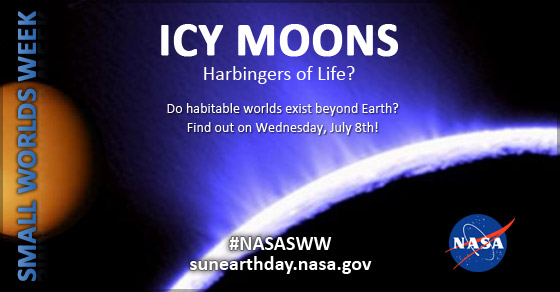
Join the discussion with NASA planetary scientists during Small Worlds Week, July 6-10!
In the depths of the dark, frigid outer solar system, sub surface oceans have been confirmed within many of the moons of the gas giant planets. These oceans are warmed and kept liquid by tidal friction from their parent planet. On their icy surfaces, cryo-volcanoes have been observed by spacecraft cameras spewing frozen water particles high above their surfaces. Could these worlds harbor life? NASA, through their outer planet programs (Voyager, Galileo, Cassini, Juno) is trying to find out.

Lou Mayo is a planetary scientist for ADNET Systems at the NASA Goddard Space Flight Center and professor of astronomy at Marymount University. He has spent over 30 years supporting NASA space and Earth science research, missions, data systems, and education including 11 years as a member of the Voyager IRIS and Cassini CIRS instrument teams. He has published a number of papers on the atmosphere of Titan and is a frequent author and speaker on space science topics.
In his free time, Lou teaches Aikido, plays basketball and volleyball, and performs magic.

Dr. Francesca Scipioni is CryoGirl in Comicpalooza 2015 in Houston. She is a postdoctoral researcher at the Lunar and Planetary Institute in Houston. Her fabulous superpowers allow her to see in the near-infrared and understand secrets of the water ice that covers the moons of Saturn. Below is her biography:
My research activity focuses on the spectroscopic analysis of the surface of Solar System airless bodies. In particular, I analyze data returned by the Visual and Infrared Mapping Spectrometer onboard the Cassini spacectraft of the main Saturn satellites in the infrared range of the spectrum. Actually, I am concentrating on three satellites Enceladus, Mimas and Thetys, while in my Ph.D. research I focused on Dione and Rhea.
Spectroscopy is very important to understand the composition and the physical state of the ice covering the surface of these objects.
By analyzing the spectrum of icy moons, mainly in the infrared range, it is indeed possible to understand the dimension of ice grains, the water ice abundance and the presence of contaminants (non-water ice elements). Moreover, this kind of research work allows the correlation of spectral information with geological features, which is a fundamental step to understand the surface composition as well as the evolution of the satellites.
I like to read, especially fantasy books, drawing, cooking and baking.
Earth's climate was seriously chilled during the Maunder Minimum (1645-1715) when no 11-year sunspot cycles were detected.